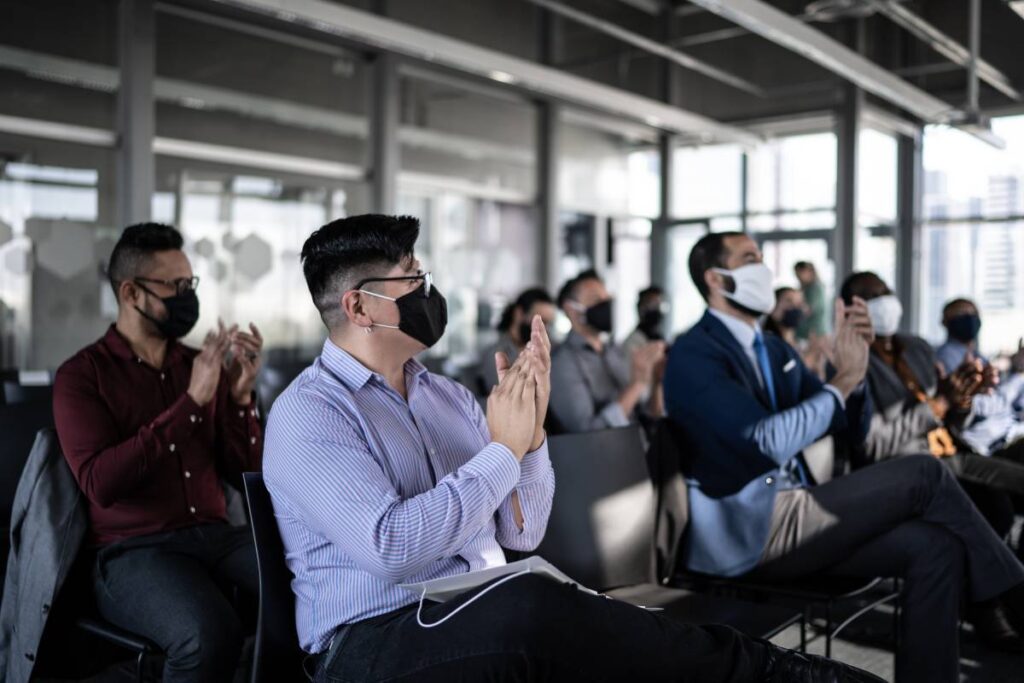Early on in the COVID-19 pandemic, “super-spreader” events, in which large groups of people came together without masks to engage in activities amenable to high aerosol production and exchange (ranging from nightclubs and concerts to religious meetings), were repeatedly reported in poorly ventilated venues – of particular threat given the strong airborne transmissibility of SARS-CoV-2 particles. Since, nearly all mass indoor gatherings events have been banned or restricted to help curb COVID-19 transmission. Following months of venue closure, in response to a rise in vaccination rates, the question of whether to once again allow large group gatherings has emerged.
Several research studies across Europe have sought to develop guidelines aimed at understanding and preventing the spread of SARS-CoV-2 during events without physical distancing between attendees [1,2].
A 2020 Spanish randomized controlled trial probed the effectiveness of a comprehensive preventive intervention for a mass gathering indoor event in the form of a live concert. Preventive measures included the systematic same-day screening of all participants with antigen-detecting rapid diagnostic tests, the use of facial masks, and the maintenance of sufficient venue ventilation. Data analyses yielded promising results, laying forth preliminary evidence of the safety of indoor mass gatherings with thorough COVID-19 transmission prevention measures [1].
Shortly thereafter, a 2021 German study found that, at a large mass gathering, while the average attendee came into direct contact with nine visitors, potential exposure to pathogens could be reduced by proper hygiene practices. Turning then to the effects of air ventilation methods revealed that two different ventilation mechanisms, each with their own air exchange rates and airflow patterns, differed by ten-fold with regard to the number of individuals ending up being exposed to infectious aerosol particles. As such, the study confirmed that the overall COVID-19 infection burden linked to mass indoor gatherings was heavily dependent on scrupulous attendee hygiene practices and the type of ventilation system used at the venue [2].
However, deeming these studies inadequately comprehensive, a 2021 French Ministry of Health-funded study sought to more rigorously probe whether infection rates among attendees at a large indoor gathering would be similar to those of non-attendees. To this end, a prospective randomized controlled trial was carried out on indoor concert attendees at Paris’ Accor Arena. Overall, data clearly revealed that, provided the implementation of comprehensive transmission prevention measures, participating in a large indoor gathering without any physical distancing precautions was not associated with a heightened risk of SARS-CoV-2 transmission [3]. However, the study was limited in several respects. Not only might participants’ behavior have been modified by the knowledge that a study was taking place, but the study took place when infection rates in France were plummeting (mostly due to the less transmissible alpha variant of SARS-CoV-2).
Taken together, however, data have demonstrated that, until SARS-CoV-2 is sufficiently controlled on a regional, national, and global level, the resumption of cultural activities may be warranted provided the implementation of a meticulous transmission prevention program beforehand, including by ensuring participants are wearing masks, implementing adequate venue ventilation, and testing attendees for COVID-19 a few days prior to or on the day of the event.
In the meantime, in an effort to keep curbing the COVID-19 pandemic as best possible, it remains critical for all individuals, vaccinated and unvaccinated, to protect themselves and others by maintaining safe physical distancing, ensuring adequate air flow in indoor spaces, and wearing surgical masks.
References
- Revollo, B. et al.Same-day SARS-CoV-2 antigen test screening in an indoor mass-gathering live music event: a randomised controlled trial. Lancet Infect. Dis. (2021). doi:10.1016/S1473-3099(21)00268-1
- Moritz, S.e t al.The risk of indoor sports and culture events for the transmission of COVID-19. Nat. Commun. (2021). doi:10.1038/s41467-021-25317-9
- Delaugerre, C. et al.Prevention of Sars-Cov-2 Transmission During a Large, Live, Indoor Gathering: The Noninferiority Randomised-Controlled Spring Trial. SSRN Electron. J. (2021). doi:10.2139/ssrn.3905915

